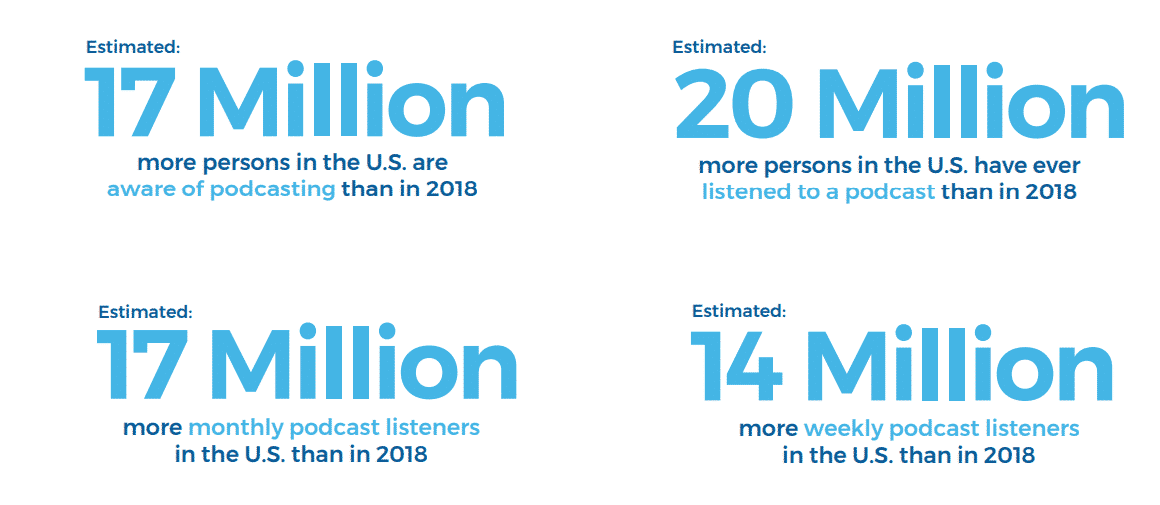
Interesting Podcast Stats to Guide Your strategy (2020 Edition)
By Daniel Ndukwu
A decade ago, podcasts were a concept few people knew about or appreciated.
Technically, they’ve been around since the 1980s but they didn’t catch on until around 2004 with the advent of portable audio devices like the iPod.
Today, they’re almost a household name and the industry is expanding rapidly.
In this article, we’ll take a look at the most recent stats from a variety of sources and help you make sense of it all so you can invest your time and energy in the right places.
- 26% of American adults (18+) listen to podcasts in their car. This is an increase from 2018 where the figure stood at 23%.
- Pandora is the most popular services for digital audio amongst US adults listened to most often by all US adults
- 70% of the US population is now familiar with the term podcast or podcasting.

- 51% of those people have listened to a podcast at least once in their lives.
- 90 million people listen to podcasts at least once a month in the United States. 26% percent of all men listened to a podcast and 29% of all women listened to podcast.
- People aged 12 – 24 were the largest segment of podcast listeners and accounted for 40% but the group aged 25 – 54 were close behind and accounted for 39% of listeners.
These podcast stats show a clear trend. More and more people are becoming interested in podcasts. What’s more, there’s a clear tipping point. More than half of the US population listens to podcasts monthly.

That’s equal to almost 200 million people. Keep in mind that these statistics don’t take the rest of the world into consideration so we can assume that number is a few hundred million larger.
What we’ll see in the next few years is an explosion in podcasts and revenue flowing into the space. This includes money spent on equipment, technology such as podcast hosts and programmatic advertising, and revenue from advertisers.
If you’ve been on the fence about starting a podcast or dedicating more time to an existing one, now’s the time to get serious about it. Soon, there will be tons of competition which happens with every industry or distribution channel.
- Society and culture is the most popular category in the Apple podcast charts followed by business, comedy, and news & politics.
- The most popular categories spike around major events. For example, the sport category spikes around the start of the NFL season while health and fitness spikes in the New Year.
Before I say anything about this, I want to make it clear that you can stand out and make a name in any category. The reason we see trends like this is because more and more people are discovering podcasts. That means the shows which appeal to a larger audience like This American Life and True Crime have more opportunities to succeed.
That doesn’t mean you can’t focus on a niche topic like SaaS software or sales. The audience is smaller but it’s more focused and may possibly command higher rates or produce more opportunities for monetization.
There is something to think about before you start a new show or go too far down any particular road. Is your total addressable market large enough to make the effort you’re going to put in worth it? If not, you may want to think twice before jumping into that niche.
Then again, if you’re doing it as a hobby and don’t have any thoughts of monetization then forget everything I just said. Have fun and don’t look back.
Finally, it may be a good idea to time a launch or a new season around major events related to your niche. As shown in the figures above, certain categories get popular during specific times of the year.
Also, prioritize building a mailing list with timely lead magnets and content upgrades. This will protect you from seasonal fluctuations.
- From 2016 to 2017 the self-reported podcast advertising revenue increased from $118.9 million to $257.4 million or 117%.
- That’s a total increase of 275% from 2015 to 2017.
- In 2020 the self-reported podcast advertising revenue is expected to grow to more than $650 million.
- Direct response style ads accounted for 64.2% of the self-reported advertising revenue and branded content ad revenue accounted for 6.5%.
- Host read ads are the favorite approach and make up 66.9% of all podcast ads
- At 85% of podcast ad revenue, cost per thousand is the dominant advertising pricing model. Series ownership comes in second place representing 7.9% of revenue generated and cost per listen represented 0% of the advertising revenue (Note: cost per listen may irrelevant because of the nature of podcast analytics. There’s currently no way to differentiate between a listen and a download).
- Integrated or edited in ads are most popular at 58.3% of the market and automatically added ads are losing market share.
- Financial services accounted for 18.1% of advertising revenue captured in 2017
Over the last few years, the revenue being spent on podcast advertising has one up and to the right consistently. How that revenue is being spent and which categories are making the most money has been fluctuating.
For example, the number of organizations that prefer host read ads is increasing because they tend to have the best response rate. More and more advertisers are focusing on CPM bidding for advertising space.
This may be due to the difficulties associated with direct attribution. Most of the time, people aren’t clicking a link to arrive at your landing pages or website – they’re typing it in to the browser.
Automatically inserted ads are losing market share. This may be because the latest crop of podcast hosts are more concerned with their brand and how it will be perceived. They don’t want programmatically inserted ads to dampen the experience of their listeners by sharing something irrelevant.
If they betray the trust of their listeners then they have no hope of succeeding over the long run.
Another factor affecting the popularity of programmatic advertising is the fact that they don’t perform as well as host read ads.
Conclusion
More than anything else, it’s important to know that the podcast industry is growing. It’s a wave that’s rapidly expanding and will reward anyone who gets in now – whether that’s as a podcaster or a service provider for the podcast industry.
There’s a caveat. Even though you’ll be riding a wave, you have to apply your energy in the right direction. If you don’t, there’s no way for you to make inroads in an already crowded market.
Copyright 2018 - 2020, KyLeads. All rights reserved.
